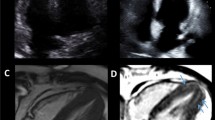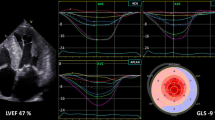Abstract
Purpose
Changes in the myocardial extracellular matrix (ECM) identified using T1 mapping cardiovascular magnetic resonance (CMR) have been only reported in obese adults, but with opposite conclusions. The objectives are to assess the composition of the myocardial ECM in an obese pediatric population without type 2 diabetes by quantifying native T1 time, and to quantify the pericardial fat index (PFI) and their relationship with cardiovascular risk factors.
Methods
Observational case-control research of 25 morbidly obese adolescents and 13 normal-weight adolescents. Native T1 and T2 times (ms), left ventricular (LV) geometry and function, PFI (g/ht3) and hepatic fat fraction (HFF, %) were calculated by 1.5-T CMR.
Results
No differences were noticed in native T1 between obese and non-obese adolescents (1000.0 vs. 990.5 ms, p0.73), despite showing higher LV mass values (28.3 vs. 22.9 g/ht3, p0.01). However, the T1 mapping values were significantly higher in females (1012.7 vs. 980.7 ms, p < 0.01) while in males, native T1 was better correlated with obesity parameters, particularly with triponderal mass index (TMI) (r = 0.51), and inflammatory cells. Similarly, the PFI was correlated with insulin resistance (r = 0.56), highly sensitive C-reactive protein (r = 0.54) and TMI (r = 0.77).
Conclusion
Female adolescents possess myocardium peculiarities associated with higher mapping values. In males, who are commonly more exposed to future non-communicable diseases, TMI may serve as a useful predictor of native T1 and pericardial fat increases. Furthermore, HFF and PFI appear to be markers of adipose tissue infiltration closely related with hypertension, insulin resistance and inflammation.




Similar content being viewed by others
References
Maron BJ, Towbin JA, Thiene G et al (2006) Contemporary definitions and classification of the cardiomyopathies: an American Heart Association Scientific Statement from the Council on Clinical Cardiology, Heart failure and transplantation committee; quality of Care and Outcomes Research and Functional Genomics and Translational Biology Interdisciplinary Working Groups; and Council on Epidemiology and Prevention. Circulation 113(14):1807–1816
Weber KT, Jalil JE, Janicki JS, Pick R (1989) Myocardial collagen remodeling in pressure overload hypertrophy. A case for interstitial heart disease. Am J Hypertens 2(12 Pt 1):931–940
Taylor AJ, Salerno M, Dharmakumar R, Jerosch-Herold M (2016) T1 mapping: basic techniques and clinical applications. JACC Cardiovasc Imaging 9(1):67–81
Jellis CL, Kwon DH (2014) Myocardial T1 mapping: modalities and clinical applications. Cardiovasc Diagn Ther 4(2):126–137
Aherne E, Chow K, Carr J (2020) Cardiac T1 mapping: techniques and applications. J Magn Reson Imaging 51(5):1336–1356
van den Boomen M, Slart RHJA, Hulleman EV et al (2018) Native T1 reference values for nonischemic cardiomyopathies and populations with increased cardiovascular risk: a systematic review and meta-analysis. J Magn Reson Imaging 47(4):891–912
Puntmann VO, Carr-White G, Jabbour A et al (2016) International T1 Multicentre CMR Outcome Study. T1-Mapping and outcome in nonischemic cardiomyopathy: all-cause mortality and heart failure. JACC Cardiovasc Imaging 9(1):40–50
Rodrigues JC, Amadu AM, Ghosh Dastidar A et al (2017) ECG strain pattern in hypertension is associated with myocardial cellular expansion and diffuse interstitial fibrosis: a multi-parametric cardiac magnetic resonance study. Eur Heart J Cardiovasc Imaging 18(4):441–450
Germain P, El Ghannudi S, Jeung MY et al (2014) Native T1 mapping of the heart - a pictorial review. Clin Med Insights Cardiol 8(Suppl 4):1–11
Hotamisligil GS (2017) Inflammation, metaflammation and immunometabolic disorders. Nature 542(7640): 177–185
Khan JN, Wilmot EG, Leggate M et al (2014) Subclinical diastolic dysfunction in young adults with type 2 diabetes mellitus: a multiparametric contrast-enhanced cardiovascular magnetic resonance pilot study assessing potential mechanisms. Eur Heart J Cardiovasc Imaging 15(11):1263–1269
Homsi R, Yuecel S, Schlesinger-Irsch U et al (2019) Epicardial fat, left ventricular strain, and T1-relaxation times in obese individuals with a normal ejection fraction. Acta Radiol 60(10):1251–1257
Toemen L, Santos S, Roest AAW et al (2021) Pericardial adipose tissue, cardiac structures, and cardiovascular risk factors in school-age children. Eur Heart J Cardiovasc Imaging 22(3):307–313
Siurana JM, Ventura PS, Yeste D et al (2021) Myocardial geometry and dysfunction in morbidly obese adolescents (BMI 35–40 kg/m2). Am J Cardiol 157:128–134
Carrascosa A, Yeste D, Moreno-Galdo A et al (2018) Body mass index and tri-ponderal mass index of 1,453 healthy non-obese, non-undernourished millennial children. The Barcelona longitudinal growth study. An Pediatr (Bar) 89:137–143
Lurbe E, Agabiti-Rosei E, Cruickshank JK et al (2016) European Society of Hypertension guidelines for the management of high blood pressure in children and adolescents. J Hypertens. 2016;34(10):1887 – 920
Mallol R, Amigo N, Rodrıguez MA et al (2015) Liposcale: a novel advanced lipoprotein test based on 2D diffusion-ordered 1H NMR spectroscopy. J Lipid Res 56:737–746
Gehan EA, George SL (1970) Estimation of human body surface area from height and weight. Cancer Chemother Rep 54(4):225–235
Dabir D, Child N, Kalra A et al (2014) Reference values for healthy human myocardium using a T1 mapping methodology: results from the International T1 multicenter cardiovascular magnetic resonance study. J Cardiovasc Magn Reson 16(1):69
Moon JC, Messroghli DR, Kellman P, Society for Cardiovascular Magnetic Resonance Imaging; Cardiovascular Magnetic Resonance Working Group of the European Society of Cardiology et al (2013) Myocardial T1 mapping and extracellular volume quantification: a Society for Cardiovascular magnetic resonance (SCMR) and CMR Working Group of the European Society of Cardiology consensus statement. J Cardiovasc Magn Reson 15(1):92
Wells JC, Cole TJ (2002) ALSPAC study steam. Adjustment of fat-free mass and fat mass for height in children aged 8 y. Int J Obes Relat Metab Disord 26(7):947–952
Wu H, Ballantyne CM (2020) Metabolic inflammation and insulin resistance in obesity. Circ Res 126(11):1549–1564
Iozzo P (2011) Myocardial, perivascular, and epicardial fat. Diabetes Care 34(Suppl 2):S371–S379
Baci D, Bosi A, Parisi L, Buono G, Mortara L, Ambrosio G, Bruno A (2020) Innate immunity effector cells as inflammatory drivers of Cardiac Fibrosis. Int J Mol Sci 21(19):7165
Sado DM, White SK, Piechnik SK et al (2013) Identification and assessment of Anderson-Fabry disease by cardiovascular magnetic resonance noncontrast myocardial T1 mapping. Circ Cardiovasc Imaging 6(3):392–398
Olivotto I, Maron BJ, Tomberli B et al (2013) Obesity and its association to phenotype and clinical course in hypertrophic cardiomyopathy. J Am Coll Cardiol 62(5):449–457
Parekh K, Markl M, Deng J, de Freitas RA, Rigsby CK (2017) T1 mapping in children and young adults with hypertrophic cardiomyopathy. Int J Cardiovasc Imaging 33(1):109–117
Cornicelli MD, Rigsby CK, Rychlik K, Pahl E, Robinson JD (2019) Diagnostic performance of cardiovascular magnetic resonance native T1 and T2 mapping in pediatric patients with acute myocarditis. J Cardiovasc Magn Reson 21(1):40
Levelt E, Mahmod M, Piechnik SK et al (2016) Relationship between left ventricular structural and metabolic remodeling in type 2 diabetes. Diabetes 65(1):44–52
Sunthankar S, Parra DA, George-Durrett K et al (2019) Tissue characterisation and myocardial mechanics using cardiac MRI in children with hypertrophic cardiomyopathy. Cardiol Young 29(12):1459–1467
Anversa P, Nadal-Ginard B (2002) Myocyte renewal and ventricular remodelling. Nature 415(6868): 240–3
Yeste D, Clemente M, Campos A et al (2021) Diagnostic accuracy of the tri-ponderal mass index in identifying the unhealthy metabolic obese phenotype in obese patients. An Pediatr (Engl Ed) 94(2):68–74
López-Cuenca Á, Manzano-Fernández S, Lip GY et al (2013) Interleukin-6 and high-sensitivity C-reactive protein for the prediction of outcomes in non-ST-segment elevation acute coronary syndromes. Rev Esp Cardiol (Engl Ed) 66(3):185–192
Fox CS, Gona P, Hoffmann U, Porter SA et al (2009) Pericardial fat, intrathoracic fat, and measures of left ventricular structure and function: the Framingham Heart Study. Circulation 119(12):1586–1591
Kleiner DE, Brunt EM, Van Natta M et al (2005) Nonalcoholic Steatohepatitis Clinical Research Network. Design and validation of a histological scoring system for nonalcoholic fatty liver disease. Hepatology 41(6):1313–1321
Ambale Venkatesh B, Volpe GJ, Donekal S et al (2014) Association of longitudinal changes in left ventricular structure and function with myocardial fibrosis: the multi-ethnic study of atherosclerosis study. Hypertension 64(3):508–515
Gottbrecht M, Kramer CM, Salerno M (2019) Native T1 and extracellular volume measurements by Cardiac MRI in healthy adults: a Meta-analysis. Radiology 290(2):317–326
Rosmini S, Bulluck H, Captur G et al (2018) Myocardial native T1 and extracellular volume with healthy ageing and gender. Eur Heart J Cardiovasc Imaging 19(6):615–621
Tribuna L, Oliveira PB, Iruela A, Marques J, Santos P, Teixeira T (2021) Reference values of native T1 at 3T Cardiac magnetic resonance-standardization considerations between different vendors. Diagnostics (Basel) 11(12):2334
Piechnik SK, Ferreira VM, Lewandowski AJ et al (2013) Normal variation of magnetic resonance T1 relaxation times in the human population at 1.5 T using ShMOLLI. J Cardiovasc Magn Reson 15(1):13
Wells JC (2007) Sexual dimorphism of body composition. Best Pract Res Clin Endocrinol Metab 21(3): 415–30
Acknowledgements
The statistical analysis was carried out in the Statistics and Bioinformatics Unit (UEB) of the Vall d’Hebron Hospital Research Institute (VHIR). The project was funded by the Spanish Society of Paediatric Cardiology and Congenital Heart Disease.
Author information
Authors and Affiliations
Contributions
Each author has contributed differently to the manuscript. Dr. Siurana, Dr. Sabaté-Rotés, Dr. Riaza, Dr. Yeste and Dr. Ventura designed the study, conducted the bibliographic search and wrote different parts of the manuscript. Dr. Riera and Dr. Vázquez contributed to gathering patient MRI data and to the discussion of the study results. Dr. Ferrer-Costa, Dr. Giralt, Dr. Gran and Dr. Rosés-Noguer participated in the laboratory and cardiac results evaluation and analysis. Dr. Siurana and Dr. Sabaté-Rotés coordinated all authors’ participation. All authors have critically reviewed and approved the manuscript.
Corresponding author
Ethics declarations
Funding
J.M.S. received the 2019 Juan V. Comas grant for this project from the Spanish Society of Paediatric Cardiology and Congenital Heart Disease.
Competing Interests
The authors have no relevant financial or non-financial interests to disclose.
Ethics Approval
This study was performed in line with the principles of the Declaration of Helsinki. Approval was granted by the Institutional Review Board at Vall d’Hebron Hospital approved the protocol (PR-AMI-273/2018).
Written informed consent for participation was obtained. All subjects provided assent and an informed consent was signed by their parents/legal guardians.
Additional information
Publisher’s Note
Springer Nature remains neutral with regard to jurisdictional claims in published maps and institutional affiliations.
Electronic supplementary material
Below is the link to the electronic supplementary material.
Rights and permissions
Springer Nature or its licensor (e.g. a society or other partner) holds exclusive rights to this article under a publishing agreement with the author(s) or other rightsholder(s); author self-archiving of the accepted manuscript version of this article is solely governed by the terms of such publishing agreement and applicable law.
About this article
Cite this article
Siurana, J.M., Riaza, L., Ventura, P.S. et al. Myocardial tissue characterization by cardiovascular magnetic resonance T1 mapping and pericardial fat quantification in adolescents with morbid obesity. Cardiac dimorphism by gender. Int J Cardiovasc Imaging 39, 781–792 (2023). https://doi.org/10.1007/s10554-022-02773-y
Received:
Accepted:
Published:
Issue Date:
DOI: https://doi.org/10.1007/s10554-022-02773-y




